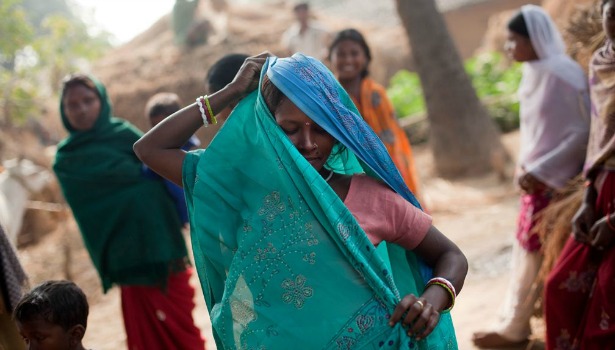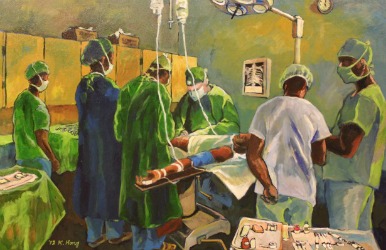Victims of a culture that puts their needs last, more women die from childbirth in India than anywhere else in the world.
The operating room was chilly on a grey morning in Bihar, Northern India. Tile floors did nothing to insulate from the thick, damp cold seeping through the blankets on rickety hospital beds.
Sugia Devi was spread on the operating table like a martyr, arms wide. But Devi wasn't dead; she was active and flailing in pain. Throughout her caesarean section she responded to each incision, each stitch, jerking her face away and moaning ghoulishly.
The doctors working on her abdomen, distracted by pulling out the baby and answering a phone call, ignored her cries. But the junior doctor standing next to her face, heard. He held down the thin gauze strip covering her eyes, pressing so strongly he indented the mounds of her cheeks. The cover was ineffective; beneath the thin cloth her eyes were visible, darting in fear.
The doctor pumped Devi full of pain medications during the surgery, and he said that after that she was moaning out of fear. Devi, however, blatantly disagreed: "I remember that I was shouting out of pain."
When she moaned Kumar shook her, then jerked her, and finally hit her, over and over during the surgery. His lip snarled and he looked angry at the disturbance. There was no concept of her cries representing a physical need or something wrong with her pain control. They were only annoying. Devi, abdomen still open, half anesthetized, uterus exposed, had no choice but to weather the health worker's blows.
Devi's physical abuse during her delivery is just one case of the violence many Indian women suffer during their reproductive lives. In the aftermath of the high-profile gang rape of a 23-year-old medical student, discussions have raged in India about the regularity of violence against women. As has been widely noted, the causes of the violence run deep. But they also are broad.
India's other sexual violence is the failure to care for pregnant women, medically and socially. The ingrained iniquities and widespread disregard for women's needs during pregnancy and childbirth contribute to India's shockingly high maternal death rates.
Bihar, where Devi's C-section took place, has among the highest rates of maternal deaths in the country. And India overall is home to the highest number of women dying from childbirth in the world. The majority of Indian women who die in childbirth are poor, uneducated, and young.
Women die around delivery mostly due to excessive bleeding, obstructed labor, infection, and issues around high blood pressure, including eclampsia. But these are the medical causes.
Women die in their homes under the watch of poorly trained midwives and village doctors. Women die in rickshaws when families make last minute runs to the health center. And many of these women die without ever having any say in decisions about their health.
Kumar's abusive behavior in the operating room directly contradicted the World Health Organization guidelines for cesarean section: "The use of local anaesthesia for caesarean section requires that the provider counsel the woman and reassure her throughout the procedure. The provider must keep in mind that the woman is awake and alert, and should use instruments and handle tissue as gently as possible."
Abuse of laboring women, while not well-tallied, is a global issue. A 2002 article in the Lancet called such abuse "a means of controlling patients" and a USAID survey cited violence at the hands of health providers as an "important barrier" to women wanting to birth in clinics.
Devi was terrified of going to the hospital, and had planned to birth at home. But when the labor failed to progress, despite hours of massaging by midwives and prayers by local priests, the family took her to a local pharmacy owned by an informally trained "village doctor."
When the informal health sector proved incompetent, and after over 24 hours in labor, the family argued over finances before finally agreeing to take Devi to the private medical clinic for the operation. The delivery cost 9,000 rupees ($167) a debilitating amount for her impoverished, low-caste family, in a state with a $360 average yearly income.
Part of Devi's problem was that she was anemic. With her low hemoglobin levels, she didn't have the physical strength to carry her through her long labor. In the months before her doctor had warned her about anemia, a common complication in India. But despite the doctor's suggestions, she ate her usual high carbohydrate diet, mostly rice and the typical flat bread, chapatti: "The food we generally eat...what else?"
Devi could not conceive of heeding her doctor's advice or choosing to increase her nutritional intake. In Bihar, less than a third of women participate in household decisions, so like her lack of say in where she would deliver, Devi probably had little influence over what she was eating.
In most families women eat after men, and daughters-in-law eat last among the women. This ingrained social norm means men eat more nutritious meals everyday, which weakens women throughout their lives and makes them more susceptible to diseases. Thirty-two percent of men in Bihar are anemic, compared to 68 percent of women. During pregnancy, malnutrition contributes to life-threatening complications.
Any time we visited Devi in the village she was patting cow dung to dry for fuel or taking long walks with the family's buffalo in the field. She continued to work until she went in to labor. Even though she had had a false start to her labor nearly a month before her delivery, she was given no time to rest between all of her household responsibilities.
While Devi was illiterate and did not know her age, in her village most women were married as young teenagers. Girls under 15 are five times more likely to die in childbirth than women in their twenties, but child brides are immediately expected to start producing children. Devi's midwife, Malti explained, "Until a woman becomes a mother, she is not valued at home." So young girls married as teenagers are immediately pressured to conceive, putting them at higher risk of obstructed labor or fistula, complications arising from the baby's head being too large to fit through the pelvis or birth canal.
In the end, Devi's baby was breach, so the caesarean section was unavoidable. But at every step in the process Devi embodied India's ongoing attacks on women, be they decisions to feed them last, marry them as teenagers, skimp on their medical care, or gang rape them on a bus. With violence permeating their sexual lives, from conception to delivery, the deadly rape cases are only the most publicized examples of a quieter epidemic.
This reporting was made possible with a joint grant from the White House News Photographers Association and PNY Technologies.
We want to hear what you think about this article. Submit a letter to the editor or write to letters@theatlantic.com.

